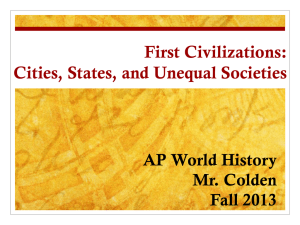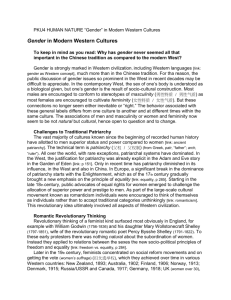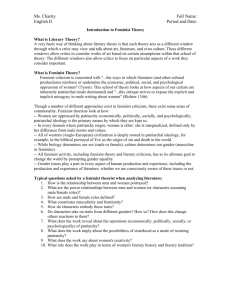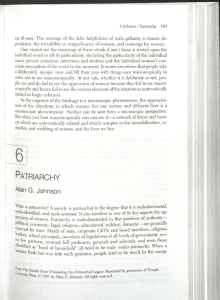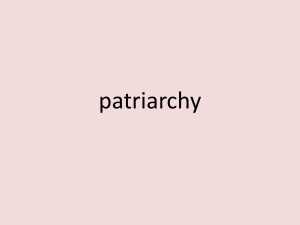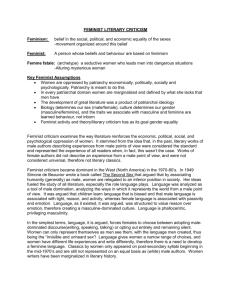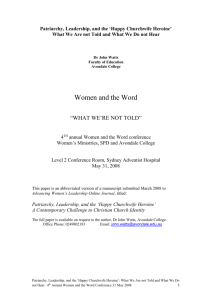CCOT - Gender Structures
advertisement
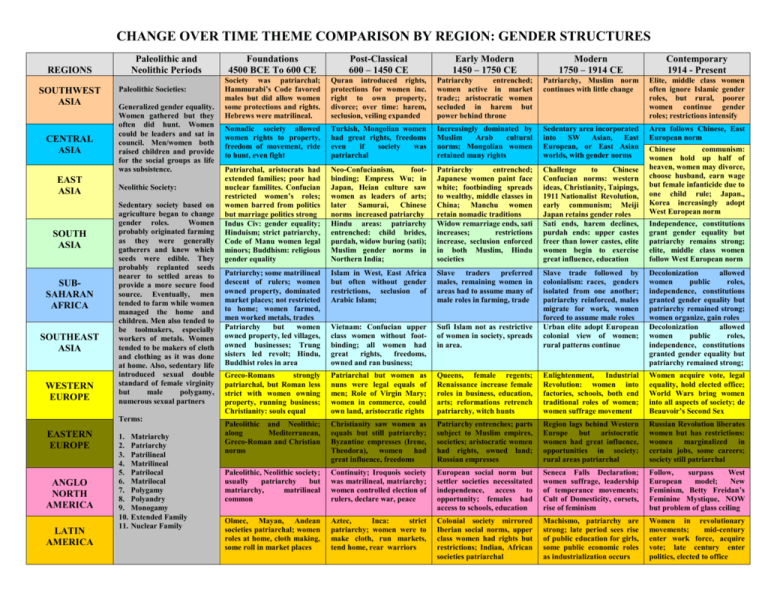
CHANGE OVER TIME THEME COMPARISON BY REGION: GENDER STRUCTURES Paleolithic and Neolithic Periods REGIONS SOUTHWEST ASIA CENTRAL ASIA EAST ASIA SOUTH ASIA SUBSAHARAN AFRICA SOUTHEAST ASIA WESTERN EUROPE Paleolithic Societies: Generalized gender equality. Women gathered but they often did hunt. Women could be leaders and sat in council. Men/women both raised children and provide for the social groups as life was subsistence. Neolithic Society: Sedentary society based on agriculture began to change gender roles. Women probably originated farming as they were generally gatherers and knew which seeds were edible. They probably replanted seeds nearer to settled areas to provide a more secure food source. Eventually, men tended to farm while women managed the home and children. Men also tended to be toolmakers, especially workers of metals. Women tended to be makers of cloth and clothing as it was done at home. Also, sedentary life introduced sexual double standard of female virginity but male polygamy, numerous sexual partners Terms: EASTERN EUROPE ANGLO NORTH AMERICA LATIN AMERICA 1. 2. 3. 4. 5. 6. 7. 8. 9. 10. 11. Matriarchy Patriarchy Patrilineal Matrilineal Patrilocal Matrilocal Polygamy Polyandry Monogamy Extended Family Nuclear Family Foundations 4500 BCE To 600 CE Post-Classical 600 – 1450 CE Early Modern 1450 – 1750 CE Modern 1750 – 1914 CE Contemporary 1914 - Present Society was patriarchal; Hammurabi’s Code favored males but did allow women some protections and rights. Hebrews were matrilineal. Quran introduced rights, protections for women inc. right to own property, divorce; over time: harem, seclusion, veiling expanded Patriarchy entrenched; women active in market trade;; aristocratic women secluded in harem but power behind throne Patriarchy, Muslim norm continues with little change Elite, middle class women often ignore Islamic gender roles, but rural, poorer women continue gender roles; restrictions intensify Nomadic society allowed women rights to property, freedom of movement, ride to hunt, even fight Turkish, Mongolian women had great rights, freedoms even if society was patriarchal Increasingly dominated by Muslim Arab cultural norms; Mongolian women retained many rights Sedentary area incorporated into SW Asian, East European, or East Asian worlds, with gender norms Patriarchal, aristocrats had extended families; poor had nuclear familites. Confucian restricted women’s roles; women barred from politics but marriage politics strong Indus Civ: gender equality; Hinduism; strict patriarchy, Code of Manu women legal minors; Buddhism: religious gender equality Neo-Confucianism, footbinding; Empress Wu; in Japan, Heian culture saw women as leaders of arts; later Samurai, Chinese norms increased patriarchy Hindu areas: patriarchy entrenched: child brides, purdah, widow buring (sati); Muslim gender norms in Northern India; Patriarchy entrenched; Japanese women paint face white; footbinding spreads to wealthy, middle classes in China; Manchu women retain nomadic traditions Widow remarriage ends, sati increases; restrictions increase, seclusion enforced in both Muslim, Hindu societies Challenge to Chinese Confucian norms: western ideas, Christianity, Taipings, 1911 Nationalist Revolution, early communism; Meiji Japan retains gender roles Sati ends, harem declines, purdah ends: upper castes freer than lower castes, elite women begin to exercise great influence, education Area follows Chinese, East European norm Chinese communism: women hold up half of heaven, women may divorce, choose husband, earn wage but female infanticide due to one child rule; Japan., Korea increasingly adopt West European norm Patriarchy; some matrilineal descent of rulers; women owned property, dominated market places; not restricted to home; women farmed, men worked metals, trades Patriarchy but women owned property, led villages, owned businesses; Trung sisters led revolt; Hindu, Buddhist roles in area Islam in West, East Africa but often without gender restrictions, seclusion of Arabic Islam; Slave traders preferred males, remaining women in areas had to assume many of male roles in farming, trade Vietnam: Confucian upper class women without footbinding; all women had great rights, freedoms, owned and ran business; Sufi Islam not as restrictive of women in society, spreads in area. Slave trade followed by colonialism: races, genders isolated from one another; patriarchy reinforced, males migrate for work, women forced to assume male roles Urban elite adopt European colonial view of women; rural patterns continue Decolonization allowed women public roles, independence, constitutions granted gender equality but patriarchy remained strong; women organize, gain roles Decolonization allowed women public roles, independence, constitutions granted gender equality but patriarchy remained strong; Greco-Romans strongly patriarchal, but Roman less strict with women owning property, running business; Christianity: souls equal Patriarchal but women as nuns were legal equals of men; Role of Virgin Mary; women in commerce, could own land, aristocratic rights Queens, female regents; Renaissance increase female roles in business, education, arts; reformations retrench patriarchy, witch hunts Enlightenment, Industrial Revolution: women into factories, schools, both end traditional roles of women; women suffrage movement Women acquire vote, legal equality, hold elected office; World Wars bring women into all aspects of society; de Beauvoir’s Second Sex Paleolithic and Neolithic; along Mediterranean, Greco-Roman and Christian norms Christianity saw women as equals but still patriarchy; Byzantine empresses (Irene, Theodora), women had great influence, freedoms Patriarchy entrenches; parts subject to Muslim empires, societies; aristocratic women had rights, owned land; Russian empresses Region lags behind Western Europe but aristocratic women had great influence, opportunities in society; rural areas patriarchal Russian Revolution liberates women but has restrictions: women marginalized in certain jobs, some careers; society still patriarchal Paleolithic, Neolithic society; usually patriarchy but matriarchy, matrilineal common Continuity; Iroquois society was matrilineal, matriarchy; women controlled election of rulers, declare war, peace European social norm but settler societies necessitated independence, access to opportunity; females had access to schools, education Seneca Falls Declaration; women suffrage, leadership of temperance movements; Cult of Domesticity, corsets, rise of feminism Follow, surpass West European model; New Feminism, Betty Freidan’s Feminine Mystique, NOW but problem of glass ceiling Olmec, Mayan, Andean societies patriarchal; women roles at home, cloth making, some roll in market places Aztec, Inca: strict patriarchy; women were to make cloth, run markets, tend home, rear warriors Colonial society mirrored Iberian social norms, upper class women had rights but restrictions; Indian, African societies patriarchal Machismo, patriarchy are strong; late period sees rise of public education for girls, some public economic roles as industrialization occurs Women in revolutionary movements; mid-century enter work force, acquire vote; late century enter politics, elected to office Independence, constitutions grant gender equality but patriarchy remains strong; elite, middle class women follow West European norm Famous Women and Identifications Ancient Period to 1200 BCE REGIONS Classical 1200 BCE To 600 CE Goddess Ishtar Semiramis Nomadic women Mary, Mother of Jesus Zenobia of Palmyra “Jezebel” Esther Ruth Isis NORTH AFRICA SUB-SAHARAN AFRICA Hatshepshut Queen Nefertiti Cleopatra Queen Amanitere Mwana Mkisi EAST ASIA Ban Zhao Amaterasu Matrieya Buddha Queen Sondok SOUTHWEST ASIA CENTRAL ASIA Mother Goddess SOUTH ASIA Post-Classical 600 – 1450 CE Khadija Chabi Shagrat al-Durr Early Modern 1450 – 1750 CE Bahitat al-Badiya Golda Meir Zainab al-Ghazali Jinnah Sadat Queen Nzinga Wangari Maathai Winnie Mandela Dowager Empress Cixi Soong Sisters Yoshiya Nobuko Jiang Qing Xue Xinran Pandita Ramabai Indira Gandhi Benazir al Bhutto Mother Theresa Raden Adjeng Kartini Corazon Aquino Aung San Suu Kyi Megawati Sukarnoputri Madame de Stael Queen Victoria Emily Pankhurst Marie Curie Florence Nightingale Olympe do Gouges Empress Maria Theresa Catherine the Great Margaret Thatcher Simone de Beauvoir Iroquois women Frontier, settler women Harriet Tubman Harriet Beecher Stowe Dolly Madison Clara Barton Susan B. Anthony Amelia Earhart Eleanor Roosevelt Betty Freidan Oprah Winfrey “Rosie the Rivieter” Margaret Mead Sor Juana Ines de la Cruz Princesa Isabel of Brazil Frida Kahlo Eva Peron Isabel Peron Violeta Chamorro Rigoberta Menchu Mira Bai Nur Jahan Trung Sisters Pwa Saw Mother Goddess Venus figures St. Monica St. Helena Catholic nuns & abbesses Mother Goddess Athena Antigone Pythia of Delphi Hypatia of Alexandria Virgin Mary Eleanor of Aquitaine Hildegaard von Bingen Heloise St. Catherine of Siena Christine of Pisan Empress Theodora Empress Irene Empress Zoe Anna Comnena Olga of Kiev SOUTHEAST ASIA WESTERN EUROPE EASTERN MEDITERRANEAN EASTERN EUROPE ANGLO NORTH AMERICA LATIN AMERICA Contemporary 1914 - Present Hurem Sultan Roxolana Empress Wu Lady Murasaki Sei Shonagon Yang Guifei Sita, Parvati, Kali, Dhruga Buddhist nuns Modern 1750 – 1914 CE Margaret of Navarre Queen Elizabeth Isabella of Spain St. Theresa of Avila Artemisia Gentileschi Regent Sophie Empress Elizabeth Alexadnra Kollontai Nadezhda Krupskaya

